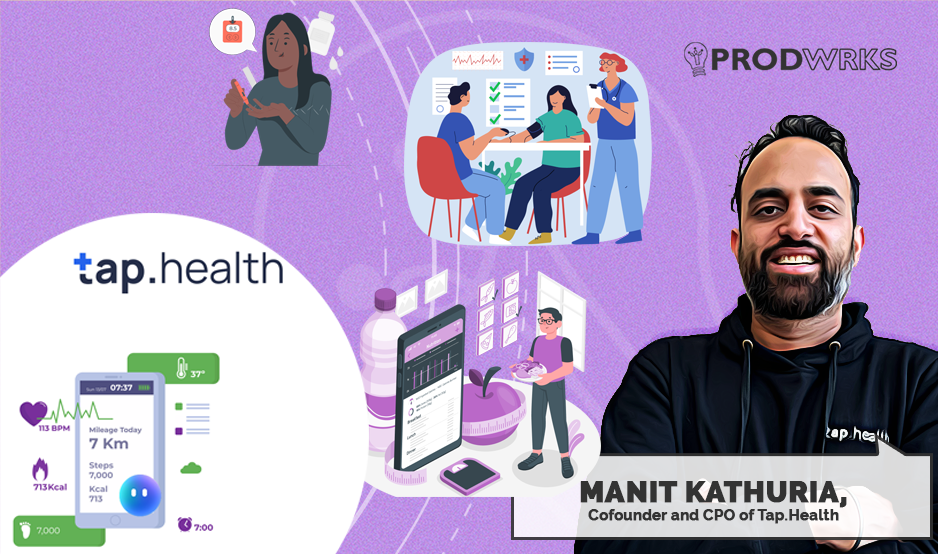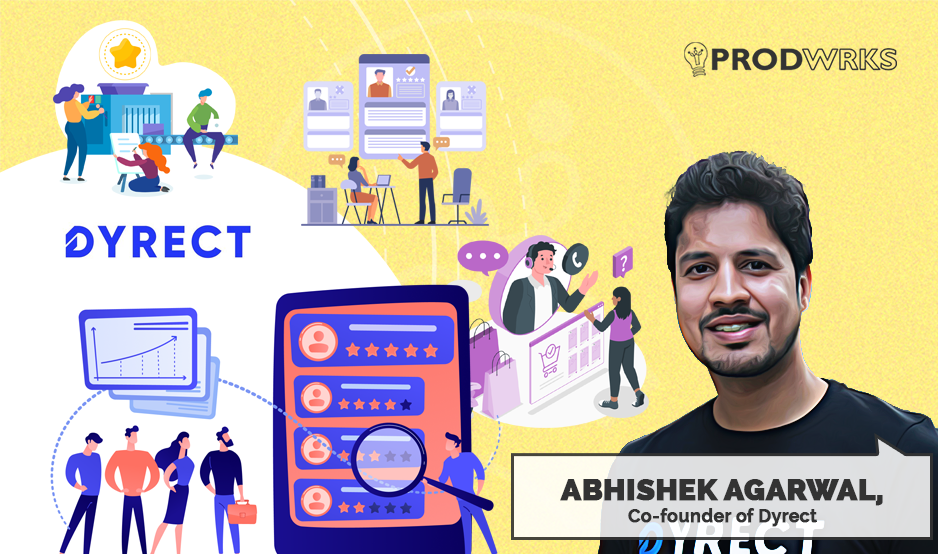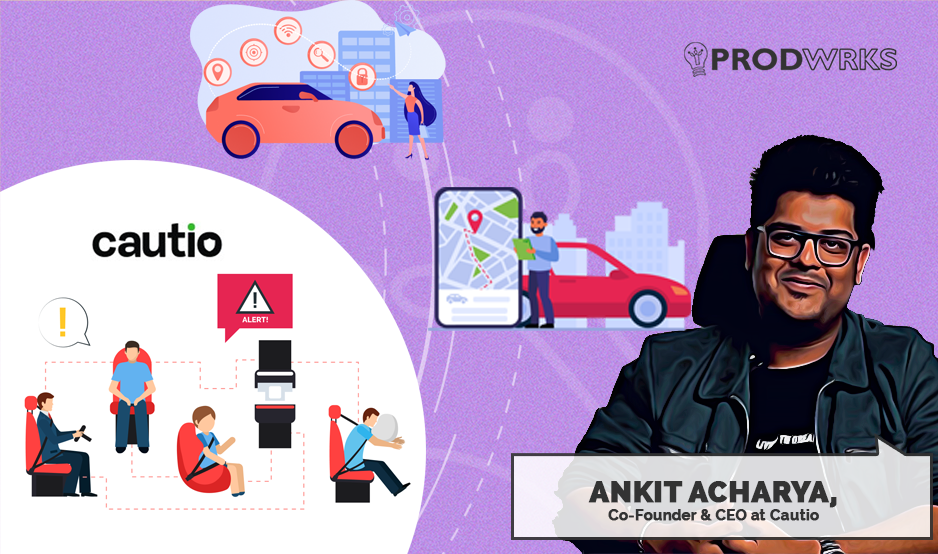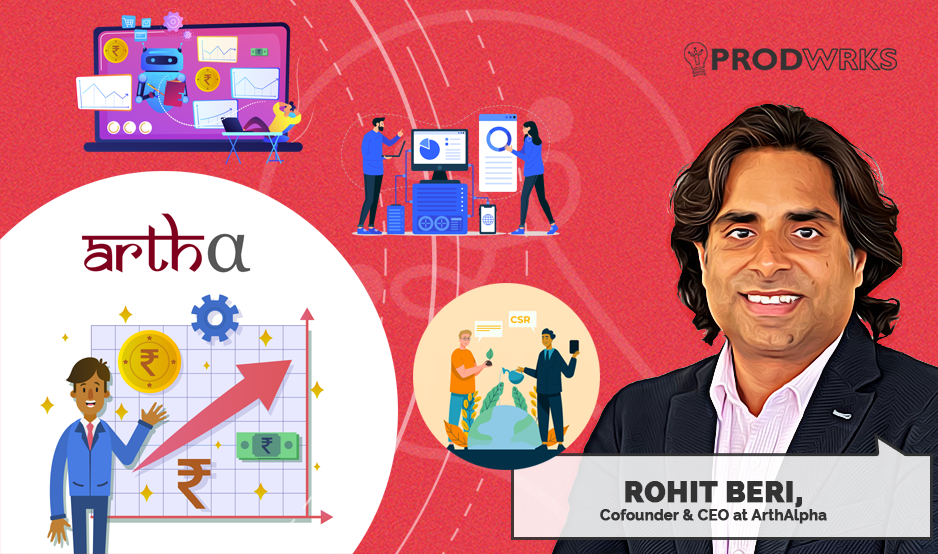
The Indian product landscape is littered with popular apps vying for attention. We can readily rattle off names like Swiggy, Cred, or Urban Company when asked about apps that offer great user experiences. But mention healthcare, and the conversation often falters.
The apps exist, certainly, but few evoke the same level of user delight or seamless integration into daily life, says Manit Kathuria, a 3x founder, seasoned product and design leader, and the Co-founder & CPO of Tap Health.
Manit sees this gap not as a failure, but as a profound opportunity.
"Healthcare in India, so far, is under-designed. It's under-loved, and it's waiting for product people like you and I to show up and shake things up," he asserts with the conviction of someone deeply immersed in the challenge. "And that's what excites me the most."
This blend of passion for product design, entrepreneurial drive, and a sense of purpose led Manit to co-found Tap Health with Rahul Maroli, former Business Head at ZEE5.
Their mission: to tackle one of India’s most pressing and rapidly escalating crises – chronic illness and lifestyle diseases – using the transformative power of AI, “not merely as a feature, but as the fundamental architecture” of their solution.
India’s Silent Epidemic & Reactive Nature of Healthcare Systems
The scale of the problem Tap Health aims to address is staggering. Around 66% of total deaths in India are caused by non-communicable diseases (NCDs), often chronic ailments caused by lifestyle habits. Four major NCDs – cardiovascular diseases, cancers, respiratory diseases, and diabetes account for over 55% of all deaths.

Diabetes, in particular, is a major problem. India, dubbed the “diabetes capital of the world,” is home to roughly 300 million pre-diabetic and diabetic individuals, nearly a third of the global total. The tragedy, Manit points out, isn’t the prevalence but late diagnosis.
"Diabetes, for example, gets late diagnosed by almost five to eight years in India," he explains. "People don't like to spend money on preventive health care. The habit of regular check-ups remains nascent, despite the recent push by healthcare startups."
Manit says, "All the digital chronic management programs in India, combined, have a subscriber base of around 300,000 people, which is nothing compared to the amount of people that need access to therapeutics (300+ million diabetics in India).”

This is often double the entire annual budget that an average diabetic patient spends on medication (₹12,000-₹17,000). Even affluent individuals balk at the cost, questioning the value proposition compared to traditional medical care or home remedies.
This is the chasm Tap Health intends to bridge. Their vision: “To make chronic care extremely simple, affordable, and deeply personalized, all powered through AI.”
Tap Health Version 1.0: The AI Health Assistant
However, Tap Health didn’t jump straight into complex chronic care management. Their journey began with an app for the early detection of ailments. “We used technology to give users an early signal about their symptoms and if they need to visit a doctor.”
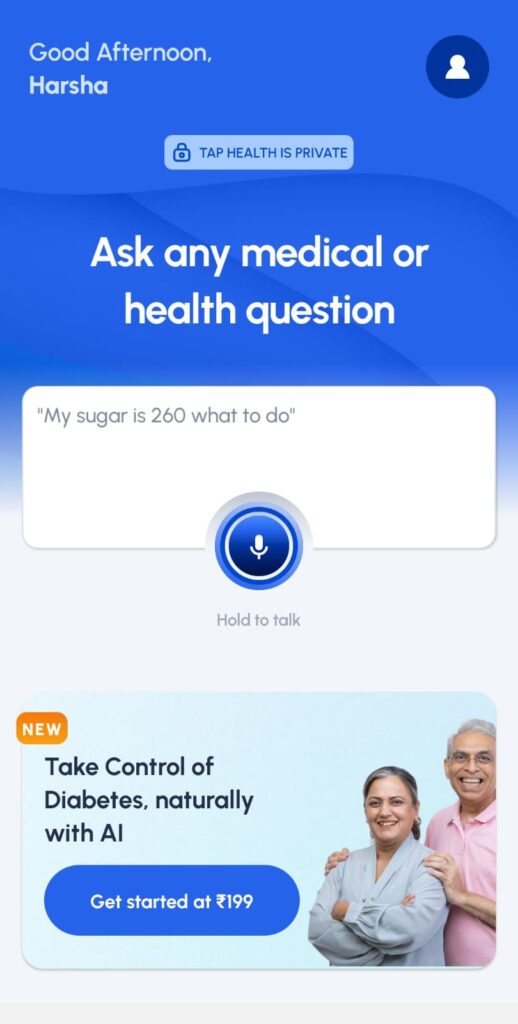
The first version of Tap Health (currently available in the Google Play Store) is an AI Health Assistant and diagnostics app launched in 2023. It allows users to ask health-related questions, describe symptoms, and get AI-driven insights. It is powered by their proprietary medical AI model, “Vaid” (Sanskrit for doctor).
Crucially, it incorporates deep natural language understanding, tuned for regional nuances and colloquialisms – a foundational investment. Manit illustrates with an example: “In north India, we may say headache, but in middle India, people may say something like ‘mere sar me gas chad gaya’… what it really means is, I have a headache.”
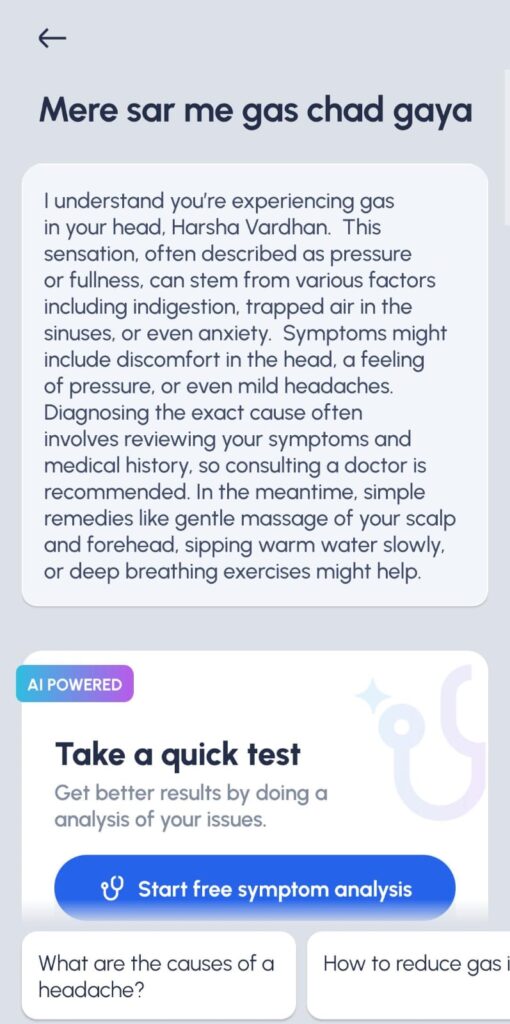
This free version achieved significant organic traction, reaching over 200,000 users with zero marketing spend, purely through word-of-mouth. Manit says, “Around 22% of users who use Tap Health for the first time, refer us to their known ones without any incentives offered!”
It served as a vital “proof of concept,” validating their core AI capabilities, particularly the Vaid symptom analysis engine, which evolved from 67% to over 93% accuracy (tested by doctors, according to Manit) and the natural language processing prowess. More importantly, it laid the essential groundwork – the building blocks – for their far more ambitious next phase.
Tap Health Version 2.0: The 100% AI-Driven Chronic Care Platform
Building on the foundation of their AI health assistant, Tap Health is now poised to launch its first monetizable product: a fully autonomous, 100% AI-driven digital therapeutic solution, starting with diabetes management.
The value proposition is disruptive: comprehensive, personalized, completely AI-driven chronic care for just ₹200 per month – less than 10% of the cost of existing human-led programs. His goal is audacious: acquire a million subscribers in the next 18 months, effectively 5x-ing the entire current DTx market in India.
What differentiates Tap Health 2.0 from other DTx programs? Manit says, “It is a sophisticated, multi-layered AI system designed not just to provide information, but to actively manage, adapt, and guide the user’s health journey.”
Manit outlines Tap Health’s USPs:
1. Zero Human Intervention: The entire program, from onboarding to daily guidance and adjustments, is codified and managed by AI. This is the core enabler of their affordability.
2. Real-Time Personalization & Adaptation: The system goes beyond static plans. It continuously learns from user inputs (diet logs, glucose readings, activity levels, even free-text voice inputs), wearable data (if available), and contextual factors to tailor recommendations dynamically.
“If you wear off course for a meal, the upcoming meals or activity levels are auto adjusted to maintain balance without rigid restrictions,” Manit illustrates.
3. Predictive Adherence & Behavioral Science: This is where Tap Health aims to truly innovate. “One of the most powerful things AI can do is understand human behavior and psychology. We use it to predict things like adherence and motivation drops. That’s actually one of the core parts of what we are solving with AI. We are not a healthcare company. We are a behavioral science and behavioral change app,” Manit emphasizes.
This focus on behavior is critical for chronic conditions where long-term lifestyle changes are paramount. The AI aims to understand the user’s “psychology” to guide them smoothly towards healthier habits, avoiding the jarring changes that often lead to drop-offs.
Architecting Intelligence: The Building Blocks of Tap Health’s AI
For the product leaders wondering about the “how” behind Tap Health’s AI, let me just say that it’s not a simple chatbot layer; it’s a deeply integrated system built on several core capabilities and philosophies:
1. Natural Language & Voice as the UI:
Manit envisions a future beyond static screens. “Screen designs are going to go away. Fluid states are the new screens.” Moving beyond rigid forms and buttons, Tap Health prioritizes conversational interaction.
"Natural language is the new UI," Manit states. "Users no longer need to adapt to your product. Your product will have to speak to them in their native language by understanding colloquial context. Voice will become the primary input, where I can just speak my feelings, and let AI understand the context."
2. AI-Driven Dynamic Experiences:</b
"For example, if a user interacts with certain features more, those features will automatically be seen higher on the screen. If there is high intent for using a feature, that feature will pop up or move up the information architecture. This is personalized to every user based on their history, longitudinal data, and how they are using the app.”
3. Modular, Systems Thinking:
"We don't start with, ‘let's build a meal logging feature’. We start with something like, what system can understand the user psychology... and then evolve their health journey accordingly. So that's the shift from features to system," Manit explains.
4. Vaid 2.0 - The Super Orchestrator:
Vaid (the AI orchestrator) commands specialized AI models for specific tasks like:
Diet Recommendation Engine: Tackling the immense complexity of Indian cuisine and taste (which changes every 100 kilometers), family eating habits, and individual preferences. The goal is familiar, sustainable adjustments, not alienating meal plans.
Exercise Generation: Using diffusion models to create thousands of personalized video exercise permutations (home-based, on-the-go, adapted for limitations like back pain or mobility issues).
Nudge Intelligence System: A sophisticated framework using ~10-15 behavioral science methodologies to orchestrate personalized, context-aware nudges, optimizing timing, frequency, and messaging to avoid overwhelming the user and maximize impact.
Content Generation: Creating personalized videos and explanations in real time to improve understanding and adherence.
Insight Engine & Data Lake: “Every activity on our phone, every click, goes into a data lake. Things like ‘How do you build insights on every user? What is an insight? How do you refresh insights? How do you connect the dots?’ This continuous data capture and analysis fuels the AI’s learning and adaptation.”
This intricate architecture allows Tap Health to offer a depth of functionality that Manit claims is “probably 30 to 50 times more complex than the first version we built” and “maybe 10 times more complex than the competition.”
This complexity, born from AI, serves as a significant competitive moat. Manit says, “Even if a very large company comes in, they will take 10 to 12 months to reach where we are today.”
Building with Deep User Understanding
Underpinning Tap Health’s technological prowess is an almost obsessive focus on user research. “Every product manager, every engineer spends about eight to 10 hours a week on this user research,” Manit reveals. The team has conducted deep qualitative interviews with over 700 doctors and 1200+ patients.
This firehose of insights requires rigorous prioritization using frameworks like MoSCoW (Must have, Should have, Could have, Won’t have) and RICE (Reach, Impact, Confidence, Effort). But the depth of understanding it provides is invaluable.
How does this research translate into product development, especially in a high-stakes field like healthcare? Manit contrasts their method with traditional approaches.
"My methodology of building products is more like SpaceX as compared to NASA," he explains. "NASA always tries to build the perfect rocket from the outset. SpaceX says let's build something, put it in the air, let it crash, and then understand what not to do. Tap Health has crashed, maybe, 13 rockets so far, iterating rapidly, sometimes making 50% jumps in the product itself every few weeks based on user testing and data.”
Healthcare MVPs in the Age of AI
"MVPs in healthcare are slightly dangerous because most MVPs are built to solve the majority of problems that users might have. But healthcare involves a lot of edge cases that could mean life or death. Knowing what the user can go wrong in and building for that 0.001% use cases is how you build in healthcare. Otherwise your product will fall flat."
"Your app needs to be ready for that moment. Our app will completely turn red, and it will connect you to emergency services (WIP). Building these critical, rarely seen pathways consumes significant resources (95% of effort, he estimates) but is non-negotiable for building trust and ensuring safety.”
Evolving Teams for an AI-First World
Tap Health’s AI-driven, research-intensive, iterative approach necessitates a different kind of team structure. Manit describes Tap Health’s three-pronged setup:
- The Finishers: Working “two months behind,” this squad focuses on polishing features based on user feedback, fixing bugs, and ensuring a smooth user experience, akin to the crew fixing snag lists in a new building.
- The Builders: Working “three months ahead,” this team builds fast, scrappy prototypes, tests hypotheses, fails fast, and sets the stage for the Finishers.
- The Explorers: Working “one year ahead,” this R&D-focused group (including PhDs and Kaggle Grandmaster types) pushes the boundaries of AI, exploring new architectures and capabilities that the product might not be ready to use today but will need tomorrow.
Go-to-Market: Targeting the Untapped Majority
With their chronic care product nearing public launch (planned around mid-May/June after extensive testing with ~1000+ users), Tap Health is shifting gears towards a structured go-to-market strategy.
Their initial target audience is sharply defined: the “lowest hanging fruits” are the estimated 2.5 million people who evaluated expensive competitor programs but didn’t purchase, likely due to cost. The core demographic is the 45-55 year old, Tier 1-3 city resident.
Manit outlines three key user personas they’re targeting:
- The Proactive DIYer: Health-conscious individuals who prefer tech-driven, self-managed solutions over human coaching. They are likely early adopters and influencers.
- The Program Evaluator: Users potentially using other platforms but seeking more automation, control, and affordability.
- The Caregiver: Family members (spouses, children) looking for effective, easy-to-use solutions for their diabetic relatives.
A particularly savvy marketing tactic involves partnering with influencers. Manit says, “We let them create organic content (reels), A/B test the performance of those reels based on engagement, and then license the most successful ones to run as paid ads.”
The Future of Healthcare Products is Adaptive, Invisible, and Systemic
Looking ahead, Manit sees Tap Health evolving beyond diabetes management into a comprehensive chronic care ecosystem, tackling hypertension, cardiac issues, respiratory ailments, women’s health, and mental health.
The ultimate vision is to become an “orchestrator” connecting users seamlessly with labs, pharmacies, and potentially doctors, acting as the intelligent layer between consultations. The AI-first, human-light model is designed for global scalability, with plans to enter the MENA region and potentially the US market (initially with a mental health focus).
But Manit’s vision extends beyond Tap Health to the very nature of digital products in the AI era.
"The next billion-dollar AI product won't look like an app," he predicts. "It won't have a login screen, it won't have a home page, it won't even have a UI... The best experiences are invisible... The winners of 2025 and beyond won't be companies that think of AI as a jacket or an add-on... but will start thinking about AI at the foundation of their product."

